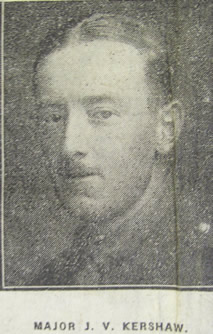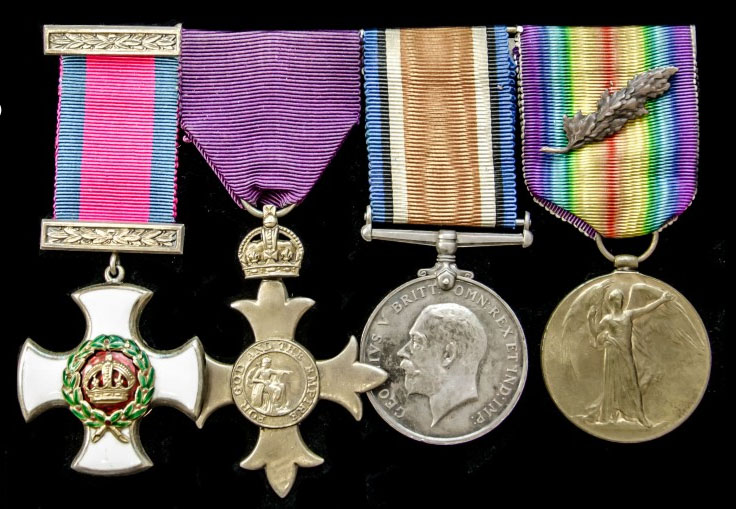11th Battalion, East Lancashire Regiment.
Awarded the D.S.O. in the London Gazette of 1 January 1918 (No citation).
Awarded the Order of the British Empire (Civil Division) in the London Gazette of
1 January 1923.
 Accrington Pals researchers have found Kershaw to be the mystery man of the Accrington Pals: he wins the D.S.O., for his successful Oppy Wood operation, gains the O.B.E., after the war and yet he hardly appears in any of the books on the battalion, which is very well documented, and no-one seems to know much about him.
Accrington Pals researchers have found Kershaw to be the mystery man of the Accrington Pals: he wins the D.S.O., for his successful Oppy Wood operation, gains the O.B.E., after the war and yet he hardly appears in any of the books on the battalion, which is very well documented, and no-one seems to know much about him.
Born born at Heywood, Lancshire, on the 18 March 1887, the son of John Edward and Myfanwy Kershaw.
1891 census; son of an Ironmonger, John Kewshaw at 11 Benfield St, Heywood, Lancashire.
1901 census; living at 60 St James St, Burnley. His father is now carrying on the trade of Licensed Victualler.
1911 census living at 77 Manchester Road Hapton. It would appear that his mother remarried in 1907. John Victor is working on his own account as an Architect and Surveyor.
17 September 1914; Appointed 2/Lt in the East Lancashire Regiment and was then posted to the 11th Service Battalion - Accrington Pals, which was to become arguably the most well known of all of Kitchener’s Pals Battalions. Kershaw would serve with the Accrington Pals for the duration of the war, being present on the 1 July 1916 when he was wounded in action when serving with ‘Y’ Company.
18 December 1915; The battalion marched out of Hurdcott Camp near Salisbury on their journey to Egypt. They sailed the next day. The Battalion consisting of 29 Officers (including 1 R.A.M.C. and 1 R.C. Chaplain) and 956 Other Ranks embarked on board the T.S.S. Ionic, and sailed the same day, under escort of 1 Destroyer.
1 January 1916; Arrived at Alexandria, after an eventfull journey in which they survived a torpedo attack by a German Uboat. They move to Port Said and spend their time in Egypt at various positions guarding the Suez Canal.
March 1916; Move to France from Egypt.
1 July 1916; The battalion suffer heavy losses at Serre. In the early evening of 30 June, the 11th East Lancashires left their camp at Warnimont Wood for a 7 mile march to the trenches in front of Serre. At 2.40am on Saturday 1 July, the leading companies of the battalion reached the front line trenches to find them already heavily shell-damaged. As daylight broke, the forward lines were again pounded by enemy shellfire. At 6.30am, the British artillery commenced its final bombardment of the German front line. At 7.20am, Captain Tough led the first of the battalion's four waves 100 yds into No Man's Land under the cover of artillery and mortar fire. A few minutes later, the second wave followed led by Captain Livesey. As shells continued to burst on the German front trench, the men of the 3rd and 4th Companies scrambled from their underground shelters bringing machine guns, rifles and grenades to bear on the attacking troops. At 7.30am, the bombardment was lifted from the German front line and the leading waves rose and walked in line towards the German positions. Machine gun- and rifle fire immediately tore into the advancing lines of infantry. One British observer likened the lines of dead to "swathes of cut corn at harvest time". Groups of Pals defied the machine gun fire, threaded their way through the barbed wire and dropped into the German front line. All was in vain. Behind, the third and fourth waves suffered dreadful losses before even reaching No Man's Land. Some of the Pals - their officers killed or wounded - pressed on towards Serre, never to be seen again. The remaining survivors in the German front line - bereft of reinforcements - were forced to withdraw. By 8am, the battle for Serre was effectively over. "The History of the East Lancashire Regiment in the Great War" records that out of some 720 Accrington Pals who took part in the attack, 584 were killed, wounded or missing. Rickman was invalided home, and returned to resume command of the Pals only on 31st May 1917.
In this, its first major action, the battalion suffered devastating losses in the attack on Serre on the opening day of the Battle of the Somme. The losses were hard to bear in a community where nearly everyone had a relative or friend who had been killed or wounded. Although the battalion was to fight again, its Pals character had been irretrievably lost.
2 August 1916. He briefly commanded the battalion at some time when Colonel Rickman was ill.
28 June 1917; the battalion takes part in a successful attack at Oppy-Gavrelle, on the day it was commanded by Maj. John Kershaw, Rickman having been detailed to be one of the reserve commanding officers. Kershaw received the D.S.O., for his part in Oppy Wood raid. The local newspaper (the Burnley Express) carried a report of him being congratulated through the paper, by the parish council of Hapton, on gaining the D.S.O., which was announced in the London Gazette on the 1 January 1918.
During 1920 and until the 17 March 1921 he was serving in Ireland with British Intelligence at Dublin Castle.
The British Army Intelligence Centre in Ireland recruited a special plainclothes unit originally of 18-20 demobilized ex-army officers and some active-duty officers to conduct clandestine operations against the IRA. The officers received training at a school of instruction in London, most likely under the supervision of Special Branch, which had been part of the Directorate of Home Intelligence since February 1919. They may also have received some training from MI5 officers and ex-officers working for Special Branch.
Army Centre, Dublin, hoped these officers could eventually be divided up and deployed to the provinces to support its 5th and 6th Division intelligence staffs, but it decided to keep it in Dublin under the command of the Dublin District Division, General Gerald Boyd, commanding. It was known officially as the Dublin District Special Branch (DDSB) and also as "D Branch". One by one, they arrived in Ireland, travelling under aliases and using commercial cover, several taking jobs as shop assistants, travelling salesmen or garage hands to avoid suspicion. Area commanders like Carew were Class GG. And the senior Intelligence men in Dublin Castle were Class FF. Besides being more experienced intelligence operatives than those earlier working in Ireland, these men increased the threat to the Irish because they immediately reorganized the British intelligence effort, which until their arrival had been decentralized and uncoordinated. They moved quickly to correct weaknesses. Their accomplishments led ultimately to the events of "Bloody Sunday."
28 February 1922 Joined British Gendarmerie in Palestine as a Major. Appointed as a Company Commander to partake in the formation of the British Gendarmerie in Palestine, what would later become known as the Palestine Police, and was posted to Nablas. Many men of the Black and Tans would volunteer for service with the British Gendarmerie in Palestine. He saw service in armoured cars on patrols, and was involved in the first ever presence of this force on the streets of Jerusalem. Kershaw commanded Gendarmerie detachments in Jerusalem and Nablas, ‘both difficult places with complete success’. He acted for the Deputy Commissioner of Police Nablas District ‘for several months during the absence on leave of the latter, and was successful in the breaking up of several notorious bands of highway robbers.’ With the reduction of the establishment, Kershaw then applied for service with the Sudan Government and as his letter of recommendation stated: ‘he has considerable experience of intelligence work having been employed in that branch in Ireland during the rebellion’.
